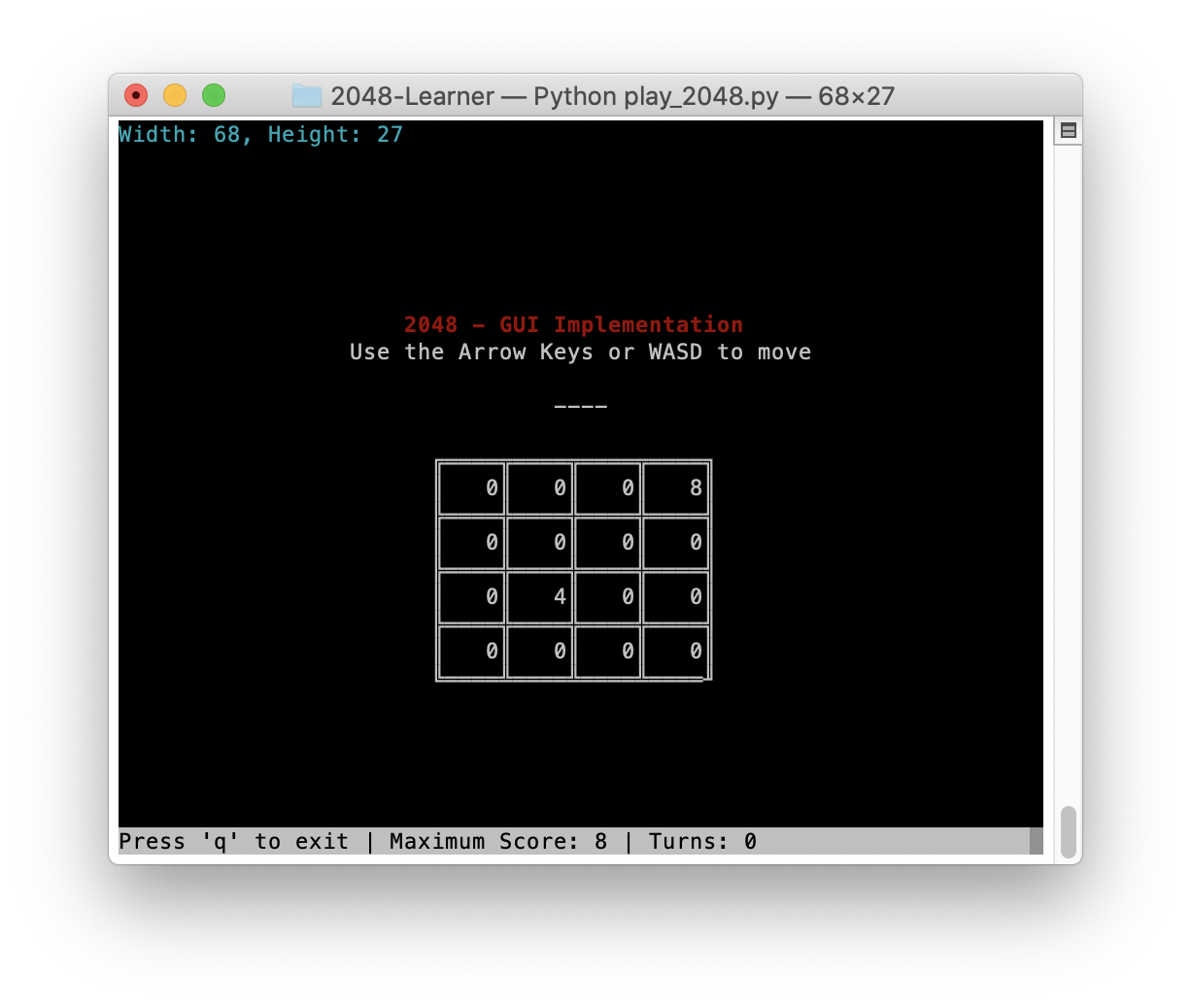Trying my hand out at Reinforcement Learning with the game 2048
The first component of this game, is of course - the actual implementation of the game 2048. I've written some code that will play the game, along with a few testbench functions, and a GUI-console-based implementation (because who doesn't like a cool game they can push buttons on)
If you want to give this all a go, you'll have to have Python 3, Numpy, and Curses installed. If you have pip installed, Curses is a simple
pip3 install curses --upgrade
or
pip install curses --upgrade
git clone this library to your computer, and you can take a look at whatever has gone on in here.
Run the GUI with python3 play_2048 once you have navigated to the directory.
You can also run it in a standard console (and print over everything)
While the GUI implementation is not scalable (It'll go up to 4 digits then break), and you can't resize the board, the actual implementation of the game in Game_2048 will work for any length of side of game board. This can be useful to expand the board for more RL searches in the future.
- Initialise board with size nxn. Randomly seed this board so that it will place 1 or 2 random values of 2,4 or 8 on the board.
- Move the board. The same "Move Left" iteration is reused for all directions, and the Numpy
rot90function is called to change the direction for movements in different directions.- For each row, iterate through each column, store a "previous" value that starts as "None".
- If a non-zero value is encountered, and "previous" is "None", replace the "previous" value with that value.
- If a non-zero value is encountered that matches the previous value, sum them and save that value, and replace "previous" with "None".
- If a non-zero value is encountered that matches the previous value, save the old previous value and replace it with the new value.
- If a zero-value is encountered, skip that cell.
- Save new values incrementally to a new list, starting from 0 and only incrementing when a new value is saved to it.
- If the moved board matches the previous state, it is not a valid move, and nothing happens after this.
- For each row, iterate through each column, store a "previous" value that starts as "None".
- Fill any empty cells (zeros) with randomly-generated 2,4, or 8.
- Check if game has ended:
- Check if any empty cells left.
- Check if any adjacent cells are identical. If no identical cells left, game is over.
- Score = Maximum tile on boards.
- Number of Turns = Number of valid moves made.
- Now works with any board size (but will have to access the python file to change the size, and due to the nature of the size of the console you can't just print a bigger board... I'll work on making this more generalised (and auto resizing in the future, but not a priority - this change was a distraction)
-
Created the
Generate_State_Tables.pyfile, which as you can tell, was intended just to generate all possible state spaces. Back of the envelope calculations led me to realise that there are over ten trillion possible permutations just to get to 2048, and this gets exponentially larger with higher values. -
Using a Dict to store the data because it's a LOT faster than a numpy array. Also, not entirely possible to generate all possible state-spaces. So have written an algorithm that explores the state space as it goes along, generating various possible permutations.
-
Updated
Game_2048.pyto have a rewards feature as well (ValidMoves).- This will first determine if a move is invalid, and assign a penalty to it.
- It then checks if the maximum cell value is in a corner. If it's in a corner and the new maximum value is higher than the previous, rewards it with the full score (i.e. whatever new cells have been created.), log(2) of the new maximum, and the number of sequential cells from this maximum cell. This is done using
GetSequence, which first rotates the board so that the maximum value is in a corner, then searches in a horizontal-first and vertical-first method to count the number of sequential blocks there are. It then takes the maximum possible score from either, and gives this as a reward too. - If no new maximum is achieved, awards the score, and also the number of sequential cells.
- Finally, if the max cell moves out of the corner, it will be given a score of 2 if the move does not get a score, or half the new score if it combines some blocks.
-
States are encoded to hexadecimal (since to get to 2048 you need about
2^11, so hex should give me lots of headroom to get to insanely huge numbers (Unlikely, I think). Each position on the board is encoded to a 16-digit hexadecimal number (more in notes). This speeds up search to O(1) instead of O(n) when looking for an already-found state.
Yet to do, will use a RL algorithm and mess around until I'm happy.
